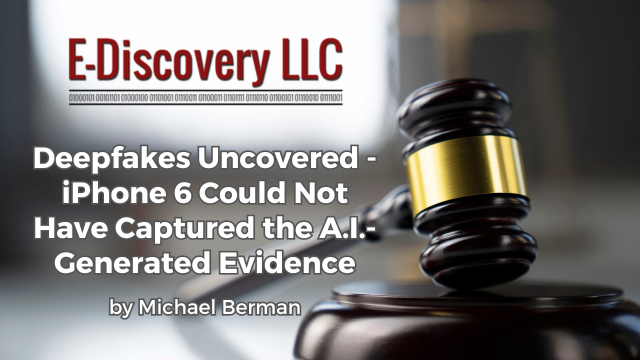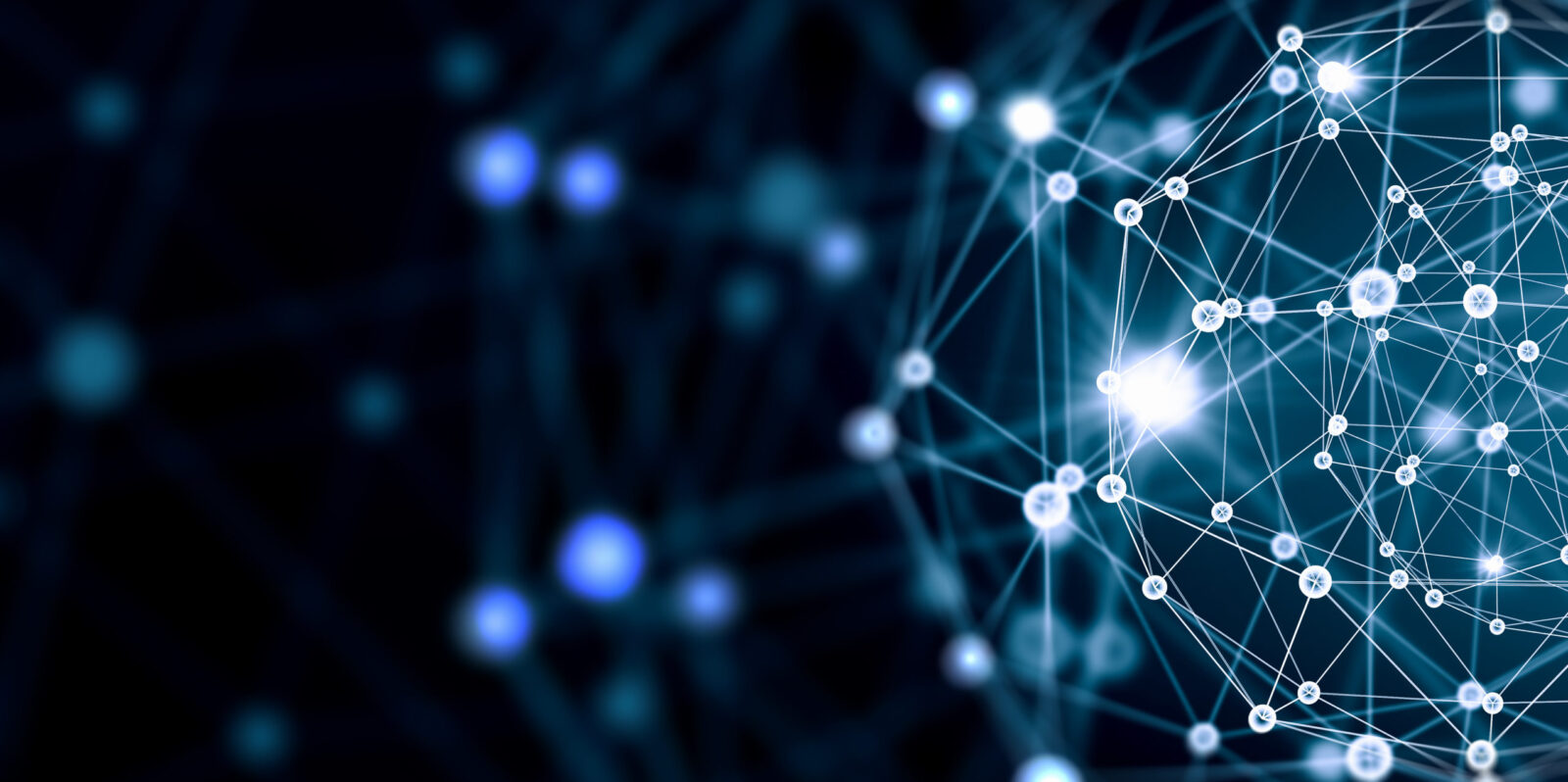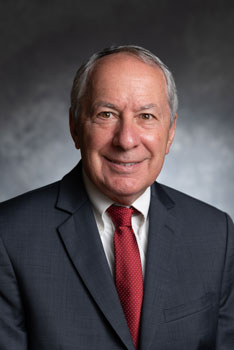
[EDRM Editor’s Note: The opinions and positions are those of Michael Berman.]
Rossbach v. Montefiore became famous because a defense forensic expert proved that an emoji, which was allegedly displayed on plaintiff’s cell phone with a harassing text message, could not have been displayed on plaintiff’s iPhone 5. The expert opined that the operating system for that phone did not support the emoji allegedly displayed on the phone.1
In the words of Yogi Bera, Mendones v. Cushman and Wakefield, Inc., 2025 WL 2613764 (Sup. Ct. Cal. Sep. 9, 2025)(Kolakowski, J.), is “déjà vu all over again.”
However, this time the context is artificial intelligence (“A.I.”). The court wrote that: “Here, the use of GenAI went beyond the submission of fictitious citations” and involved “deepfakes.”
In Mendones, the court suspected that altered evidence had been submitted and ordered plaintiffs to explain. In part, plaintiffs replied that the evidence “was captured on an Apple iPhone 6 Plus using its rear camera and running iOS 12.5.5.”
The Mendones court wrote: “Here’s the problem for [plaintiff] Maridol Mendones: Apple did not introduce Apple Intelligence until iOS18 and required an iPhone 16, iPhone 15 Pro, or iPhone 15 Pro Max.” That’s Rossbach all over again.
Here’s the problem for [plaintiff] Maridol Mendones: Apple did not introduce Apple Intelligence until iOS18 and required an iPhone 16, iPhone 15 Pro, or iPhone 15 Pro Max.
Mendones v. Cushman and Wakefield, Inc., 2025 WL 2613764 (Sup. Ct. Cal. Sep. 9, 2025)
The Mendones court was considering a motion for terminating sanctions against plaintiffs for intentionally submitting false testimony. Plaintiffs had moved for summary judgment. The court wrote that:
Upon review, the Court suspected Plaintiffs’ exhibits 3, 6A, 6B, 6C, 7, 21, 27, 35, and 40 of having been altered or created by generative artificial intelligence (GenAI). For instance, exhibits 6A, 6C, and 36 purport to capture the speech and image of Geri Haas. But, while exhibit 36 appears to capture a real-life interaction, certain characteristics of exhibits 6A and 6C, such as the lack of facial expressions, the looping video feed, among other things, suggested that these exhibits were products of GenAI—i.e., “deepfakes.”
Mendones v. Cushman and Wakefield, Inc., 2025 WL 2613764 (Sup. Ct. Cal. Sep. 9, 2025).
The court held a hearing and: “At the hearing on June 12, 2025, the Court’s suspicion was reinforced when [plaintiff] Maridol Mendones mentioned that some witnesses depicted in the suspect evidentiary submissions were deceased or could not be contacted by her.”
The court then issued an order to show cause why terminating sanctions should not issue against plaintiffs. In the order, the court wrote in part:
The Court notes that some of the purported testimony submitted by Plaintiffs appears to be products of generative artificial intelligence. (Compare Pls.’ Mot. Summ. J. Ex. 36 (capturing speech and image of Geri Haas), with Exs. 6A & 6C (purporting to capture speech and image Geri Haas); see also Exs. 3, 6B, 6C, 7, 21, 27, 35, 40.) The Court is also suspicious of the authenticity of other evidentiary submissions.
Id.
The court wrote that it is “attentive to the issue of improper use of generative AI before it.” It posed a series of questions to plaintiffs and directed that the responses be under oath.
Upon review of the responses, the court found that plaintiffs had submitted fabricated evidence in support of their summary judgment motion. It wrote:
The Court finds that exhibits 6A and 6C are products of GenAI and do not capture the actual speech and image of Geri Haas. In other words, these exhibits are deepfakes.
Id.
The court posted links to several videos, one of which (Exh. 6A) is re-posted here – https://drive.google.com/file/d/1xI3xCC6Xdq94PZvz7QCl6M_XDsg8q55k/view 2
The court wrote:
While the “person” depicted in exhibits 6A and 6C bears a passing resemblance to the person depicted in exhibit 36, they are not the same person. The accent, cadence, volume, word choice, pauses, gestures, and facial expression, among other characteristics, of the person depicted in exhibit 36 are vastly different from those demonstrated by the “persons” depicted in exhibits 6A and 6C. The “persons” depicted in exhibits 6A and 6C lack expressiveness, are monotone, do not pause at moments where pauses are expected, use odd words choices, and appear generally robotic. Further, the mouth flap does not match the words being spoken. Juxtaposing these three videos together, it becomes clear that whoever the “persons” depicted in exhibits 6A and 6C are, they are not the person depicted in exhibit 36.
The oddities of exhibits 6A and 6C are typical features of videos created by GenAI.
Id.
Reviewing another exhibit, Exh. 7,3 the Mendones court wrote: “The lighting, contrast, color, and sharpness of the man depicted in these pictures compared with the lighting, contrast, color, and sharpness of the background shows that the man was stitched into the photograph taken by the Ring camera. A close inspection shows that the background is in black and white, while the man is in color.” It compared the photos to others and found material alteration.
As to other evidence, Exhs. 35 and 40,4 the court wrote: “In their declaration, Plaintiffs stated that the messaging platform in exhibit 35 is Instagram and exhibit 40 is a Zoom iPhone group chat. These statements strain credulity: Looking at the menu bar on the lower part of the images, it is clear to this Court that exhibits 35 and 40 seem to depict the same messaging platform. Further, the font style, spacing, and sizing appear off on exhibit 40, suggesting the names and messages were altered.”
The court also found the metadata to be altered. It contained information not typically found in metadata, such as a copyright assertion. The court wrote that it “suspects that material metadata was added at some later point in time by someone with access to the files and with editing privileges.”
That brings us back to the similarity to Rossbach. The Mendones court wrote:
The Court did not find Plaintiffs’ explanations in their respective declarations to be credible. Notably, in response to the first question, Maridol Mendones declared that artificial intelligence was used in all videos marked as exhibits 6A to 6D. (Pls.’ Decls. at 3:23–26.) Maridol Mendones sought to shift the blame to Geri Haas for providing her with this video testimonial. (See id. at 3:13–4:3.) Her explanation, however, is not credible: Assuming the veracity of the metadata, exhibit 6A was captured on an Apple iPhone 6 Plus using its rear camera and running iOS 12.5.5. (See id. at p. 16.) Here’s the problem for Maridol Mendones: Apple did not introduce Apple Intelligence until iOS18 and required an iPhone 16, iPhone 15 Pro, or iPhone 15 Pro Max. (See Apple Inc., Apple Intelligence, https://www.apple.com/apple-intelligence/ (last visited September. 5, 2025.) (“Apple Intelligence is available in beta on all iPhone 16 models, iPhone 15 Pro, iPhone 15 Pro Max, iPad mini (A17 Pro), and iPad and Mac models with M1 and later, with Siri and device language set to the same supported language, as part of an iOS 18, iPadOS 18, and macOS Sequoia software update.”).) As such, Maridol Mendones explanation about why the person depicted in exhibit 6A is robotic is unbelievable. [emphasis added].
Id.
Before imposing sanctions, the court wrote: “The Court remains suspicious of the [four] other evidentiary submissions, but it does not have the time, funding, or technical expertise to determine the authenticity of Plaintiffs’ statements or conduct a forensic analysis of the suspect evidentiary submissions.”
The Court remains suspicious of the [four] other evidentiary submissions, but it does not have the time, funding, or technical expertise to determine the authenticity of Plaintiffs’ statements or conduct a forensic analysis of the suspect evidentiary submissions.
Mendones v. Cushman and Wakefield, Inc., 2025 WL 2613764 (Sup. Ct. Cal. Sep. 9, 2025).
Finding that monetary sanctions were not appropriate, it wrote:
Here, the use of GenAI went beyond the submission of fictitious citations. Plaintiffs submitted at least two exhibits created by GenAI. Further, to an even greater extent than expressed by the Hayes court, the use of deepfakes in a case significantly undermines the Court’s ability to administer justice, significantly erodes the public’s confidence in the judicial system, and significantly burdens under-resourced and overworked courts with the time-consuming task of assessing whether evidence presented to it during pretrial proceedings was a deepfake. As such, a more severe sanction is appropriate. [emphasis added].
Id.
The court decided that referral for criminal prosecution was not appropriate because it would be “too severe and not sufficiently remedial.” It also found that evidence and issue sanctions were not appropriate: “While an evidentiary or issue sanction would exclude some things that can be shown to be created by GenAI, others might sneak through the Court’s or opposing party’s analysis. Without robust safeguards to guard against future misuses of the legal proceedings, an evidentiary or issue sanction is effectively toothless.”
The court concluded that terminating sanctions were appropriate. The action was dismissed with prejudice.
Thanks to Mary Mack and EDRM for alerting me to this case.
Notes
- Rossbach v. Montefiore Medical Center, 2021 WL 3421569 (S.D.N.Y. Aug. 5, 2021), aff’d in part, vacated in part, remanded, 81 F.4th 124 (2d Cir. 2023), is discussed in Fabricated Text Messages – – Some Lessons Are Never Learned (Jan. 14, 2025). ↩︎
- Unfortunately, screenshots referenced by the court are not viewable on Westlaw. ↩︎
- Id. ↩︎
- Id. ↩︎
Assisted by GAI and LLM Technologies per EDRM GAI and LLM Policy.


